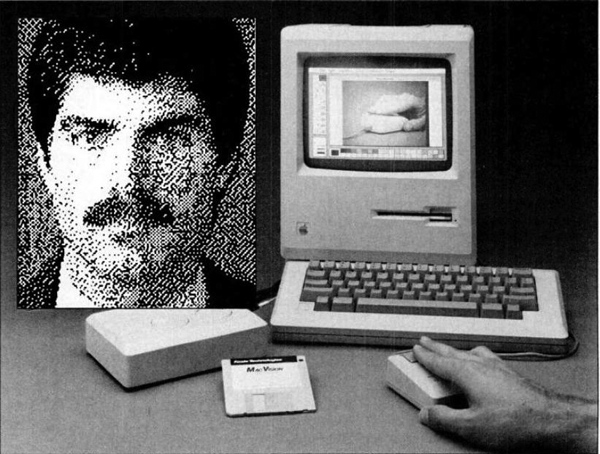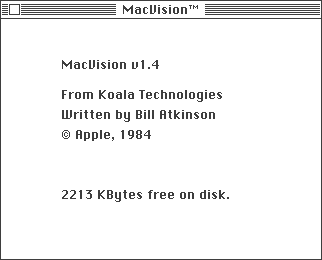296 words
3K on disk
January 1985
 Switcher
Switcher
Task Switcher
Origin
Andy left Apple in March 1984, even before Jobs, his mentor, was bounced out of the company. Working on his own, often without prospect of payment, Andy set about supporting the computer in which he had invested so much passion. Working as an independent programmer, he wrote Switcher, enabling Mac to handle more than one application at a time; besides licensing the program to Apple and others, he distributed it electronically, for free.
— Steven Levy, in Wired 2.04
Context and Uses
My own personal setup involves a Macintosh XL with 1 megabyte of memory. I’ve got two Switcher documents or sets that I use frequently. The first is my day-to-day set which includes MacWrite configured at 144K (so I can print to the LaserWriter), MacDraw, MacPaint, Multiplan, and Red Ryder, all at 128K, and the Finder at 128K. My second set is for creative work and I use it for preparing sales materials, manual mockups and intimidating memos. Try MacWrite at 144K, MacDraw at 128K, MacPaint at 128K and PageMaker at 256K. (Note these configurations are only for XL users or Macintosh owners with 1-megabype upgrades.) For manual production, create MacPaint readable screen dumps of the illustrations you want to include by typing the Command, Shift and 3 keys simultaneously. Touch up the screen dumps in MacPaint, copy them to the Clipboard, switch to MacWrite and paste them in the appropriate spot.
At home on my 512K Macintosh I use Switcher with the Finder, Dollars & Sense, and Red Ryder. When I’m doing my home accounting I can quickly access my electronic banking service and make certain that all my electronic transactions are included in my Dollars & Sense ledger accounts.
— Dan Cochran (Apple Marketing), in MacUser Dec 1985
Version History
To Come
 Software | Permalink | No Comments
Software | Permalink | No Comments
150 words
2K on disk
January 1985
 1985 Shareholder Meeting
1985 Shareholder Meeting
On January 24, 1985, at the annual Apple Shareholder’s meeting, Steve Jobs previewed to an amazed audience an even more amazing piece of code that let Macintosh users switch between different applications almost instantly.
That software was, of course, Switcher — written by Andy Hertzfeld and the origin of an idea which would result in MultiFinder. What is interesting about this particular software demo is that Jobs himself showed off software which was written outside the offices of Apple, and by an engineer who was in the process of separating himself from the company.
Further, despite “dazzling the crowd,” according to InfoWorld Switcher was an unquestionable move away from the one-screen simplicity of the original Mac.
We can trace Steve’s interest in one-task-at-a-time computing to the abandoned “Single Window Mode” of Mac OS X Public Beta, to the iPhone and iPad, and finally the Full-Screen mode of OS X Lion.
 Expos | Permalink | No Comments
Expos | Permalink | No Comments
195 words
2K on disk
November 1984
 MacVision
MacVision
Digitizer

Koala MacVision was a $400 combination hardware/software interface to digitize still frames from a video camera or VCR. The MacVision box plugged into either the Printer or Modem port. Data streamed in somewhat slowly: small frames took about six seconds to appear, whereas a full-screen image took 22 seconds. Obviously, one needed either a still subject or a device with good freeze-frame capabilities, such as a VideoDisc player.
Software authored by Bill Atkinson, and probably contained an early implementation of the “Atkinson Dithering” which would reappear in the software for Thunderscan. Curiously, the About Box for early versions credited Apple Computer — it’s possible that some of Atkinson’s work on dithering algorithms was done while he was still full-time at Apple:

Initially the software shipped as a Desk Accessory, so that it was available from other programs. Version 2.0 and above were standalone applications.
BMUG Fall 1985 Choice Product
“It’s fast and it can digitize 3D images from a video camera or videotape. Its resolution isn’t quite as good as the Thunderscan.”
Driver
Link to versions 1.4, 2.0 and 3.0 from the Mac Driver Museum.
Manual
Scan of the v3.0 manual, circa 1990.
 Hardware | Permalink | 4 Comments
Hardware | Permalink | 4 Comments
26 words
0K on disk
May 1984
 ThunderScan
ThunderScan
Printing in reverse

BMUG Fall 1985 Choice Product
“Has the best resolution, but it’s slow. Can only digitize objects by reading into the Imagewriter I (only) printer.”
 Hardware | Permalink | No Comments
Hardware | Permalink | No Comments
 Switcher
Switcher


